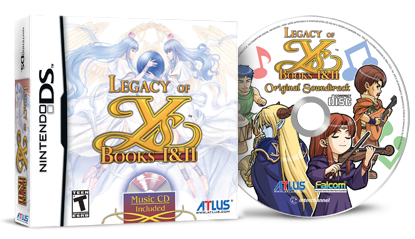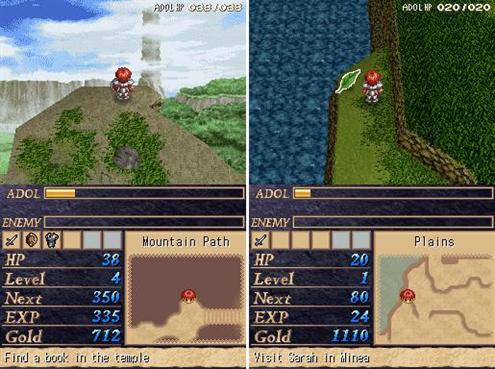 If you don’t know how to pronounce it, don’t worry ”“ neither does the rest of North America. Despite having been released in DOS, on the Famicom, and a slew of other platforms, the Ys RPG series only saw major stateside release on the Turbographix 16 – and even this version of the game was extremely difficult to find until it was finally released on the Nintendo Wii’s Virtual Console. After being remade and re-released countless times in Japan, the latest Ys remake has finally made it’s way to US shores on the Nintendo DS – and it’s very polished rendition – although it’s quirks might betray it’s age and leave you a bit frustrated.
If you don’t know how to pronounce it, don’t worry ”“ neither does the rest of North America. Despite having been released in DOS, on the Famicom, and a slew of other platforms, the Ys RPG series only saw major stateside release on the Turbographix 16 – and even this version of the game was extremely difficult to find until it was finally released on the Nintendo Wii’s Virtual Console. After being remade and re-released countless times in Japan, the latest Ys remake has finally made it’s way to US shores on the Nintendo DS – and it’s very polished rendition – although it’s quirks might betray it’s age and leave you a bit frustrated.
Oh, and pronouncing the title? It’s somewhat like the word “ease.” Try pluralizing the “y” sound in “happy” and you’ve got it.
Much like wine,beer,and escargot, Ys is an acquired taste. It’s a shining example of a title adored by it’s fans, yet often rejected by newcomers. If you’ve never played Ys I & II in it’s previous iteration, you’ll probably find the game confusing, vague, awkward, aggravating, and tedious – and the excuse is the same as the explanation: Ys is old, and it shows. The original Ys and it’s follow up were released in 1986 and 1987, receptively. For their time Ys I & II were amazing, featuring sprawling dungeons, fast action, and fully animated cut scenes. While amazing in 1986, the way in which these fantastic feats were accomplished may frustrate the contemporary player.
 One of the reasons the dungeons of Ys seem so large is a result of their non-linear design. In an area with four or five floors you might find yourself searching for a key that’s on the forth floor, using that key to unlock a door on the first floor, obtaining an item that unveils a previously unseen path on the third floor, where you might find something to allow you to proceed on to the fifth floor. While all good RPGs have some dungeon crawling and exploring, this exercise becomes tedious fast, as some passageways appear only when you have certain items equipped. In 1986 this design allowed for a bigger adventure while re-using the same areas to minimize the digital footprint of the game, but today it’s just frustrating. Exploring is fun, but not to tedium.
One of the reasons the dungeons of Ys seem so large is a result of their non-linear design. In an area with four or five floors you might find yourself searching for a key that’s on the forth floor, using that key to unlock a door on the first floor, obtaining an item that unveils a previously unseen path on the third floor, where you might find something to allow you to proceed on to the fifth floor. While all good RPGs have some dungeon crawling and exploring, this exercise becomes tedious fast, as some passageways appear only when you have certain items equipped. In 1986 this design allowed for a bigger adventure while re-using the same areas to minimize the digital footprint of the game, but today it’s just frustrating. Exploring is fun, but not to tedium.
In contrast to the non-linear dungeons, the storyline is somewhat straight forward once you figure out where you are supposed to go. Talking to townspeople gives you an idea of where the story heads next and finding the correct contact puts you on the next leg of your Journey. Sometimes finding the right person isn’t always easy, but much like the dungeons – exploring everything and talking to everybody will eventually point you in the right direction. Ys also has an interesting twist on the “Silent Protagonist,” although the main character, Adol, never speaks for himself, his thoughts and actions are conveyed by narration. For instance, if someone where to ask “Adol, how are you,” the game would declare “Adol says that he is fine.” It’s different to be sure, and it sets the game’s narrative style apart from crowd.
 Combat varies slightly between settings: Stylus, and Normal. Oddly enough, the “Stylus” mode is actually the “Normal” Ys battle system – a unique setup where the player attacks the enemy by simply running into them. Running into enemies head on most often causes the monster to damage the player, while hitting an enemy from a slight angle, the sides, or the back inflicts damage. It may feel a little strange at first, but this is actually one of the high points of the game – the stylus control is easy to master, fun, and fast paced. Once you get the hang of it, destroying waves of enemies is easy and enjoyable. “Normal” mode reflects Zelda Controls – the player character is moved with the D-Pad while a button attacks enemies in range. The result feels less natural and forced, hitting enemies with the sword is actually harder than simply running into them with the stylus, and requires precise timing to score a hit rather than take damage.
Combat varies slightly between settings: Stylus, and Normal. Oddly enough, the “Stylus” mode is actually the “Normal” Ys battle system – a unique setup where the player attacks the enemy by simply running into them. Running into enemies head on most often causes the monster to damage the player, while hitting an enemy from a slight angle, the sides, or the back inflicts damage. It may feel a little strange at first, but this is actually one of the high points of the game – the stylus control is easy to master, fun, and fast paced. Once you get the hang of it, destroying waves of enemies is easy and enjoyable. “Normal” mode reflects Zelda Controls – the player character is moved with the D-Pad while a button attacks enemies in range. The result feels less natural and forced, hitting enemies with the sword is actually harder than simply running into them with the stylus, and requires precise timing to score a hit rather than take damage.
Legacy of Ys is split up into “Books I&II,” each book representing “Ys” and “Ys II,” as they were released in 86 and 87. The two games comprise of one story, and were originally sold separately. As such, it’s no surprise when you’re stats and items don’t transfer to Book II after you complete Book I – although they are two parts to the same story, they still remain two separate games, played independently of each other. Despite this, you’ll find little difference in the two titles except two major observances – the first, is that Book II introduces Magic as a combat and dungeon exploring element, replacing many items from the first game with spells. The second feels like a limitation – an awkward “area loading” in strange places – holding up the game as it loads the next section of a seemingly “open” field. These “zone loading” areas seem out of place, and abruptly break the flow of gameplay.
 In the end, Legacy of Ys for the DS is a visually updated retro RPG that shows it’s age. Newcomers to the series may suffer some frustration, but can still appreciate the design of a game that may have been too ambitious for it’s time. For long time fans, it’s probably a worthwhile purchase – it’s a good recreation of the classic RPG with new control and graphic variants, and the CD soundtrack pack in is a great addition. The bottom line? If you’re aching for a new RPG or simply want to try out a well respected classic, Legacy of Ys for the DS isn’t a bad choice …if you don’t mind clinging to a walkthrough. If your frustration isn’t worth full price but you’re still interested, check out the “definitive” TG16 version on the Virtual Console. In the end, a gussied up 23 year old game plays like one – if you aren’t up for some good ‘ol dungeon crawling challenge, pass this one up.
In the end, Legacy of Ys for the DS is a visually updated retro RPG that shows it’s age. Newcomers to the series may suffer some frustration, but can still appreciate the design of a game that may have been too ambitious for it’s time. For long time fans, it’s probably a worthwhile purchase – it’s a good recreation of the classic RPG with new control and graphic variants, and the CD soundtrack pack in is a great addition. The bottom line? If you’re aching for a new RPG or simply want to try out a well respected classic, Legacy of Ys for the DS isn’t a bad choice …if you don’t mind clinging to a walkthrough. If your frustration isn’t worth full price but you’re still interested, check out the “definitive” TG16 version on the Virtual Console. In the end, a gussied up 23 year old game plays like one – if you aren’t up for some good ‘ol dungeon crawling challenge, pass this one up.
![]()
